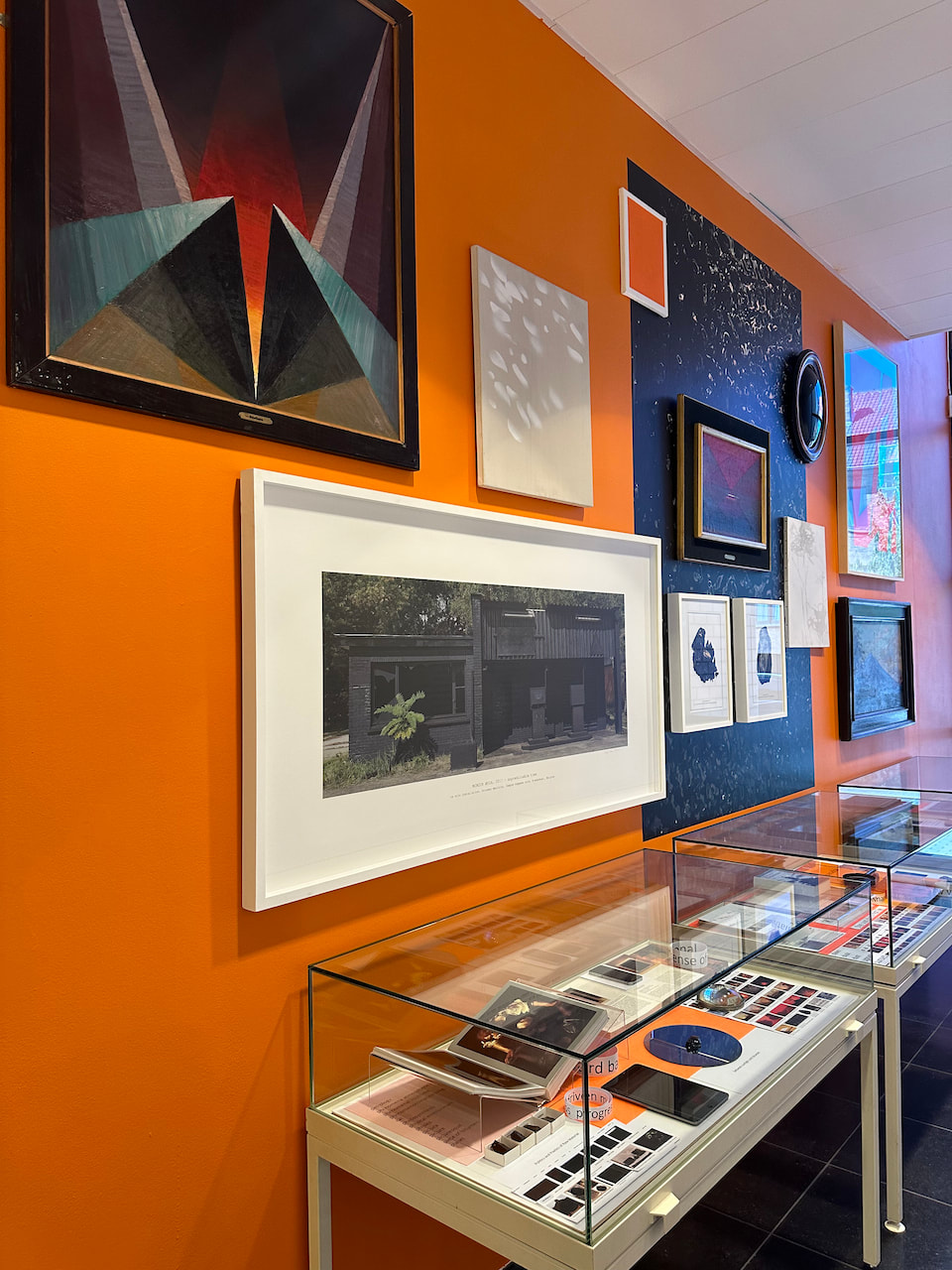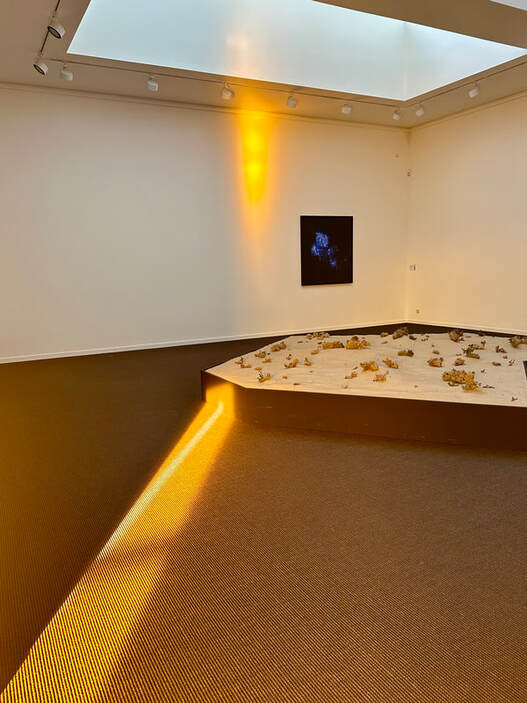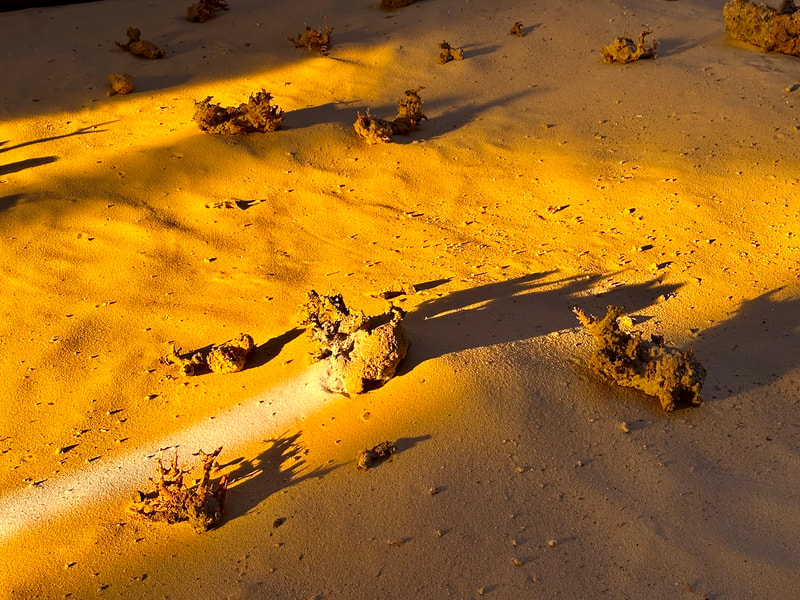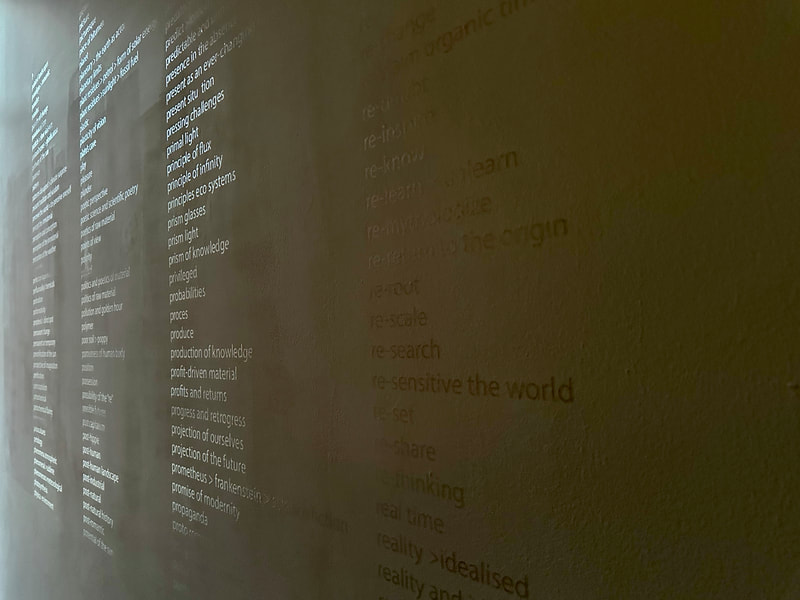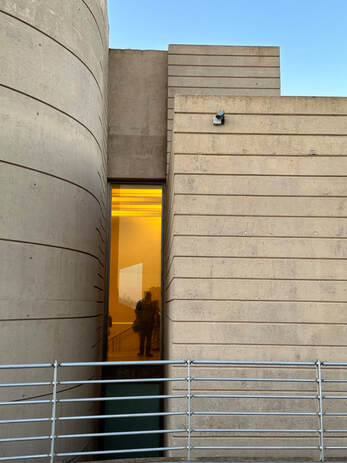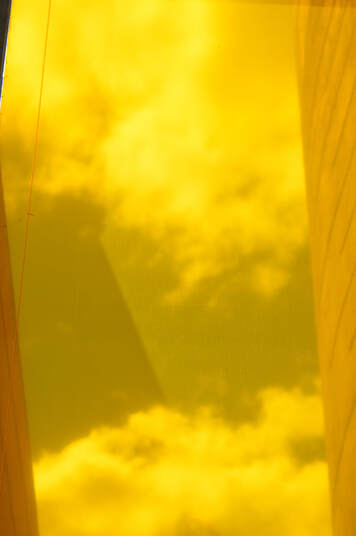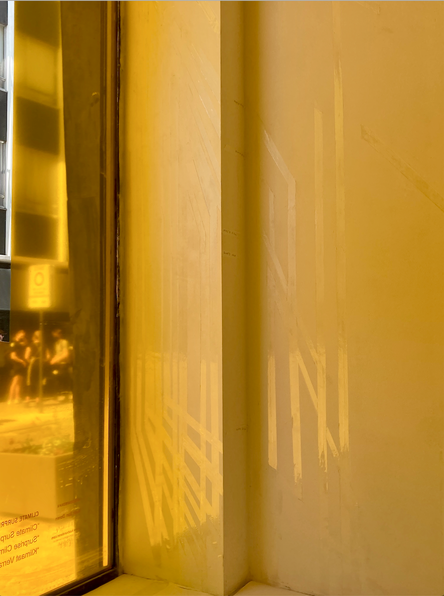|
SHIFTING SCENERIES
FeliXart & Eco museum Drogenbos -BE 26 augustus 2023 - 28 januari 2024 Do/Thu – Zo/Su: 10:30 – 17:00 https://felixart.org/tentoonstelling/gist-shifting-sceneries With: Tina Gillen, Alice Vanderschoot, Isabel Fredeus, Maarten Vanden Eynde, Marjolijn Dijkman, Kaat Van Doren, Elias Cafmeyer en Suzette Bousema. Cabinet of Romantic Paradox nr 1, 2023
(Artefacts, natural objects, paintings, books, thumbnails, digital prints, and analogue photographs etc. from my own collection or from Felix art & Eco Museum.) Cabinet of Romantic Paradox nr 1, 2023
(e.g.round mirror with living bitumen, iPad,4 small obsidian stones, monography Caravaggio,Aztec book with examples of black mirror from obsidian,1996 Kaat Van Doren black rectangle photogram, iPhone , etc...) 
Cabinet of Romantic Paradox nr 1, 2023
(e.g.dried sherd earth summer '22 Aragon Sp,snail shell, anonymous painting 19th E Tambora , thumbnails 1816 The year without a Summer, digital prints research solar plants in Aragon Sp, Stonehenge albumineprint 1890,etc....) |
GOLDEN HOUR
|
|
in situ installation
Waiting For:GOLDEN HOUR 22.08.23/ 13:30u (orange foil, transparent tape and sunlight) |
in situ installation
Waiting For:GOLDEN HOUR 22.08.23/13:30u from 13:30u -18:00 floor transparent tapedrawing sunlight projection (orange foil, transparent tape and sunlight) |
Fragment Post Romantic Index Between Bitumen and Sunlight
(sunlight, transparent lettering on white wall)
(sunlight, transparent lettering on white wall)
ESPERANDO LA HORA DORADA
(luz solar, vinilo naranja, cinta transparente)
permanent instalación in situ
48°52’ 25’’N, 0°24’ 58’’W
15.07.2023 till today
Centro de Arte Y Naturaleza Huesca, Aragon SP
http://www.cdan.es/arte-y-naturaleza/

5.11.2023 13:41u

15.07. 2023 13:45u

Klik hier om te bewerken.
30.09.2023 13:43u

30.09.2023 13:35u

30.09.2023 12:56u

30.09. 2023 13:02u

5.11.2023 13:29u
KAAT VAN DOREN
Instalación in situ
WAITING FOR GOLDEN HOUR / ESPERANDO LA HORA DORADA 48°52’ 25’’N, 0°24’ 58’’W
(luz solar, vinilo naranja, cinta transparente)
El título ESPERANDO LA HORA DORADA se refiere por un lado a mi añoranza por la Hora Dorada, la hora romántica de una hermosa tarde de verano cuando todo se sumerge en un cálido resplandor anaranjado.Por otro lado, es un ligero guiño a Samuel Beckett: “En attendant, il ne se passe rien”. Mi deseo es una paradoja romántica. Junto con esta hora romántica antes del atardecer, se graban en mi retina imágenes distópicas de la contaminación del aire (desde los incendios forestales y la contaminación del aire en todoel mundo, desde España hasta la industria petroquímica en Amberes). Cuanto más anaranjado se vuelve el cielo durante el día, más fuerte es la contaminación del aire. El sol no miente: con sus largas ondas de luz roja, hace que la contaminación sea visible a simple vista, mientras que todas las demás ondas de luzobservables son bloqueadas por las partículas contaminantes.
En contraste con “la velocidad” del movimiento continuo de la tierra como tal, los movimientos de la humanidad para contrarrestar el calentamiento global parecen durar para siempre. ¿Estamos esperandouna hora dorada permanente con hermosos cielos “románticos” en todo el mundo? La artista invierte sutiempo en la recolección y presentación del tiempo mismo; esto por sí solo está en marcado contraste conlas normas del trabajo económicamente rentable. Es más bien una labor de amor: como la hija de Butadesen el mito de Plinio, Van Doren registra, en diálogo con el sol, lo que le es querido; ella crea una indicación tangible de lo que pronto desaparecerá en la ausencia.
La instalación in situ ‘Waiting For Golden Hour’ se baña en el ciclo natural de la luz solar y activa la percepción sensorial y espacial y pone los conceptos de tiempo e (im)previsibilidad en una perspectiva poética. La disposición in situ es condicional, lo que se puede ver depende de si el sol brilla o no. Este aspecto condicional exige literalmente tiempo al espectador. A pesar de la tiranía contemporánea de la inmediatez y la velocidad, ¿esperará el espectador a que el sol arroje sus nuevas imágenes de luz en elpatrón de líneas previamente establecido? ¿Alguna vez una imagen de luz proyectada por el sol vuelve acaer en el mismo lugar? El arreglo in situ literalmente ilumina el encuentro humano con el tiempo solar. Unaimagen material cuenta cómo el sol juega a través del tiempo en el espacio en una interacción constante con la luz solar incorpórea.
Un homenaje a la belleza de la (in)certidumbre ya la voluntad condicional de la naturaleza, en la que el hombre ya no es el gobernante central de la tierra sino que está indisolublemente ligado a ella. Un intento de restaurar elcontacto humano con los fenómenos naturales a través de la imaginación. Siempre que las personas occidentales urbanizadas con mentalidad tecnológica presten más atención a la comprensibilidad de la naturaleza, la naturaleza puede educarlos nuevamente. La instalación in situ tiene como objetivo que el visitante se comprometa con el paisaje. Una reflexión sobre la(des) creencia occidental en la inteligibilidad de la naturaleza. Nos atrevemos amirar desde el futuro a lo que una vez se dio por sentado en todo el mundo: un rayo de sol llega a la tierra.
“La relación ambigua entre la humanidad y el resto de la naturaleza siempre ha jugado un papel en la obra de Van Doren. Entre otras cosas, le interesa cómo la cientificación e industrialización de Occidente va acompañada de una pérdida de conexión con la naturaleza. Para la clase media urbana, la naturaleza se está convirtiendo en un telón de fondo o decoración: algo que admiramos desde la distancia, en pinturas románticas o en espectaculares documentales sobre la naturaleza. Es la materia de los sueños y el arte: algo quevemos a través de un marco, pero a lo que nosotros mismos no pertenecemos. Nos hemos apartado significativamente de la vida del agricultor, que dependede la clemencia del tiempo, la tierra y el aire para su supervivencia y la nuestra también. Sobre todo, esto cuelga la sombra de las industrias extractivas que explotan la tierra, la crisis climática y un velo literal y figurativo decontaminación. La instalación in situ de Van Doren Waiting For Golden Hour es una especie de experiencia posromántica, sublime pero crítica, del sol como una fuerza de la naturaleza. El trabajo tiene el potencial de sugerir unanueva conexión entre el ser humano y la naturaleza, pero también plantea cuestiones ecológicas y existenciales”.
Beheydt, T. (2021). Sunlight as a primary material in the oeuvre of Kaat Van Doren. In
K. V. Doren, Waiting For: Golden Hour. Belgie: Stockmans Art Books.
in situ installation GOLDEN HOUR
long term research installation 2019-till unpredictable date
Artist run space_Guldenstraat 17_ Mechelen, BE
51°01’31”N - 4°28’37”E
The installation is visible from the street.
Visits by appointment [email protected]
(orange foil, sunlight, transparent tape)
in situ installation GOLDEN HOUR
long term research installation 2019-till unpredictable date
Artist run space_Guldenstraat 17_ Mechelen, BE
51°01’31”N - 4°28’37”E
The installation is visible from the street.
Visits by appointment [email protected]
(orange foil, sunlight, transparent tape)

Klik hier om te bewerken.
“Van Dorens' in situ installation Golden Hour is a kind of post-romantic, sublime but critical,
experience of the sun as a force of nature. The work has the potential to suggest a new connection between humans and nature, but also raises ecological and existential questions.”
uit: Beheydt, T. (2021). Sunlight as primary material /In K. V. Doren, Waiting For: Golden Hour. Belgie: Stockmans Art Books.
PRESS/PERS
Els, Roelandt "Klimaatstress en de romantische paradox"
H ART magazine, nr 227 gepubliceerd op 06/09/2022
https://hart-magazine.be/
klimaatstress_en_de_romantische_paradox.pdf
Danckaers, Tine, artikel “Ons tegensprekelijk geluk? Dat we kinderen van de zon zijn.”
MO Mondiaal Nieuws, gepubliceerd op 26/12/2020
https://www.mo.be/interview/ons-ontegensprekelijke-geluk-dat-we-kinderen-van-de-zon-zijn
‘ons_ontegensprekelijke_geluk__dat_we_kinderen_van_de_zon_zijn’_-_mo_.pdf
experience of the sun as a force of nature. The work has the potential to suggest a new connection between humans and nature, but also raises ecological and existential questions.”
uit: Beheydt, T. (2021). Sunlight as primary material /In K. V. Doren, Waiting For: Golden Hour. Belgie: Stockmans Art Books.
PRESS/PERS
Els, Roelandt "Klimaatstress en de romantische paradox"
H ART magazine, nr 227 gepubliceerd op 06/09/2022
https://hart-magazine.be/
klimaatstress_en_de_romantische_paradox.pdf
Danckaers, Tine, artikel “Ons tegensprekelijk geluk? Dat we kinderen van de zon zijn.”
MO Mondiaal Nieuws, gepubliceerd op 26/12/2020
https://www.mo.be/interview/ons-ontegensprekelijke-geluk-dat-we-kinderen-van-de-zon-zijn
‘ons_ontegensprekelijke_geluk__dat_we_kinderen_van_de_zon_zijn’_-_mo_.pdf

Golden Hour in situ installation: Sunlines (spring equinox 2019 till spring equinox 2021)
(sunlight, foil, transparent adhesive tape, vinyl, )
(sunlight, foil, transparent adhesive tape, vinyl, )
|
GOLDEN HOUR
(NDL) In-situ-installatie in Mechelen, Guldenstraat 17 (B), 2019-2021 langlopend project Mechelen ligt op ongeveer 20 km van de haven van Antwerpen en zijn petrochemische cluster (1), midden op de industriële as Antwerpen-Brussel. In 1835 werd in Mechelen de eerste spoorlijn geopend. Voor het eerst in de geschiedenis reed een trein met stoomlocomotieven over het Europese continent, de motor achter het industriële succes van België in de 19e eeuw. Mechelen was ooit de hoofdstad en bakermat van kunst en cultuur van de Habsburgse Nederlanden. Op loopafstand van het standbeeld van Margaretha van Oostenrijk (2), staat een gildehuis De Gouden Zalm, oorspronkelijk gebouwd in de 16e eeuw. De neoclassicistische gevel uit de 18e eeuw is in de jaren vijftig op de begane grond verbouwd tot winkel. In de grote vitrine met veel aandacht voor invallend daglicht, kenmerkend voor de modernistische architectuur bevindt zich de installatie Golden Hour (3). De eigenschappen van het zonlicht veranderen de winkelpui in een "Golden Hour". Het oranje vinyl dat op de vitrine is aangebracht, met enkele perspectivische openingen, filtert het zonlicht (4). Door de tijd heen zijn op de muren markeringen aangebracht waar het zonlicht is geweest. Laat het heden zien dat de toekomst in het verleden ligt? Golden Hour is bedoeld als een poëtische metafoor voor een vloeiend proces van voortdurend worden en vergaan. Binnen de verstedelijkte context poogt de installatie de aandacht te vestigen op de organische tijd en de zintuigen opnieuw aan te scherpen voor de aanwezigheid en onze afhankelijkheid van natuurverschijnselen zoals zonlicht. Tegelijkertijd is het romantische verlangen naar het Golden Hour in de huidige Capitalocene situatie, met wereldwijd permanent oranje luchten als gevolg van luchtvervuiling (5), een paradoxaal verlangen. 1. Total in de haven van Antwerpen, op 19/02/2020, kleurde de hemel in Antwerpen vuurrood door een afflakking. Dit veroorzaakte twee dagen lang een rode gloed in de Antwerpse lucht. Die vlam zie je niet alleen, maar hoor je ook, zelfs met de ramen dicht. Volgens Total kan de afflakking erg luidruchtig zijn, maar brengt het absoluut geen gevaar met zich mee. De vlam bevindt zich op zo'n 200 meter hoogte en is dus op een veilige hoogte. De vlam is er 365 dagen per jaar, maar alleen tijdens het afflakkelen is het fenomeen zo duidelijk zichtbaar. 2. Margaretha van Oostenrijk was van 1507 tot 1530 landvoogdes van de Habsburgse Nederlanden en koos Mechelen als haar woonplaats. In 1521 veroverden de Spanjaarden onder leiding van H. Cortés Mexico op de Azteken. Op 20 augustus 1523 schonk keizer Karel V een groot deel van de waardevolle en unieke voorwerpen aan zijn tante, Margaretha van Oostenrijk, die ze gebruikte om haar goed uitgeruste bibliotheek aan haar hof in Mechelen in te richten en zo het eerste Azteekse museum in Europa te creëren. Deze collectie bevatte ook voorwerpen van goud en obsidiaan. In de astronomie van Meso-Amerika waren de zon, de maan en Venus de drie belangrijkste hemellichamen, en het was op hun bewegingen dat de verschillende inheemse kalendersystemen werden gebaseerd. 3. Gouden Uur verwijst naar het mooiste uur, ook wel "magisch uur" genoemd, waarmee de korte periode na zonsopgang of voor zonsondergang wordt aangeduid waarin er meer indirect zonlicht is, waardoor het licht roder en zachter wordt. Omdat de zon aan de horizon staat, legt het licht een langere afstand af door de atmosfeer. Rode lichtgolven zijn het langst, blauwe lichtgolven zijn korter en worden meer verstrooid, zodat het rode licht meer aanwezig is. 4. Zonlicht is het zichtbare deel van het totale spectrum van elektromagnetische straling dat door de zon wordt uitgezonden. Het zonlicht dat de aarde bereikt is maar een heel klein deel van de totale hoeveelheid, maar essentieel om het leven op aarde in stand te houden. Fijn stof is onzichtbaar voor het blote oog. Het wordt alleen zichtbaar door de eigenschappen van het zonlicht en bepaalde weersomstandigheden. 5. Primaire stofdeeltjes zijn het resultaat van verbranding, wrijving of verdamping. Voorbeelden zijn de verbranding van fossiele brandstoffen zoals olie, aardgas, steenkool en hout. |
|
Follow the sun in The Golden Hour Installation MIDSUMMERDAY 21/06/2019 (from 16:47u till 18:30u )
Research fase 2019 |
GOLDEN HOUR long term research installation 2019-till unpredictable date (ENG) In-situ installation in Mechelen, Guldenstraat 17 (B), 17.03.2019, long-term project Mechelen is situated about 20 km from the port of Antwerp and its petrochemical cluster (1) in the middle of the Antwerp-Brussels industrial axis. In 1835 the first railway line was opened in Mechelen. For the first time in history, a train with steam locomotives ran on the European continent, the driving force behind Belgium's industrial success in the 19th century. Mechelen was once the capital and cradle of art and culture of the Habsburg Netherlands. Within walking distance of the statue of Margaret of Austria (2), stands a guildhall The Golden Salmon, originally built in the 16th century. The neoclassical facade from the 18th century has been converted on the ground floor into a shop in the 1950s. The large display case with great attention to incident daylight, characteristic of modernist architecture contains the installation Golden Hour (3). The properties of the sunlight turn the shop front into a “Golden Hour”. The orange vinyl applied to the display case, with some perspective openings, filters the sunlight (4). Throughout time, markings have been made on the walls where the sunlight has been. Does the present show that the future lies in the past? Golden Hour is intended as a poetic metaphor for a flowing process of constant becoming and decaying. Within the urbanised context, the installation attempts to draw attention to organic time and reawaken our senses to the presence and dependence of natural phenomena such as sunlight. At the same time, the romantic longing for the Golden Hour in today's Capitalocene situation, with worldwide permanent orange skies as a result of air pollution (5), is a paradoxical desire. 1. Total in the port of Antwerp, on 19/02/2020, the sky in Antwerp turned fire-red due to a flacking. This caused a red glow in the sky of Antwerp for two days. Not only do you see that flame, but you also hear it, even with the windows closed. According to Total, the flacking can be very noisy but it brings absolutely no danger. The flame is at a height of about 200 metres and is therefore at a safe height. The flame is there 365 days a year, but it is only during flacking that the phenomenon is so clearly visible. 2. Margaret of Austria was governor of the Habsburg Netherlands from 1507 to 1530 and chose Mechelen as her place of residence. In 1521, under the leadership of H. Cortés, the Spaniards conquered Mexico from the Aztecs. On 20 August 1523 Emperor Charles V donated a large proportion of valuable and unique objects to his aunt, Margaret of Austria, who used them to decorate her well-equipped library at her court in Mechelen, thus creating the first Aztec museum in Europe. This collection also contained objects made of gold and obsidian. In the astronomy of Mesoamerica, the sun, moon and Venus were the three most important celestial bodies, and it was on their movements that the various indigenous calendar systems were based. 3. Golden Hour refers to the most beautiful hour, also called “magic hour”, which indicates the short period after sunrise or before sunset in which there is more indirect sunlight, making the light redder and softer. Because the sun is on the horizon, the light travels a longer distance through the atmosphere. Red light waves are the longest, blue light waves are shorter and are scattered more, so the red light is more present. 4. Sunlight is the visible part of the total spectrum of electromagnetic radiation emitted by the sun. The sunlight reaching the earth is a very small part of the total amount, but essential to sustain life on earth. Fine dust is invisible to the naked eye. It only becomes visible because of the properties of sunlight and certain weather conditions. 5. Primary particulate matter is the result of burning, friction, or evaporation. Examples are the burning of fossil fuels such as oil, natural gas, coal, and wood. |
